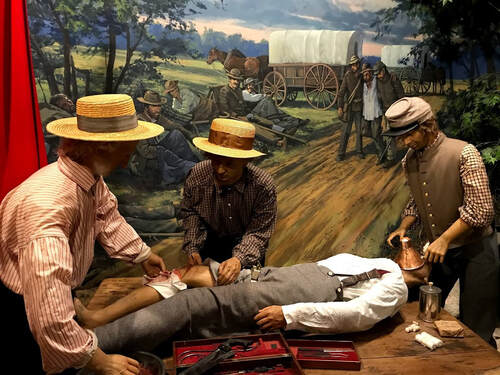|
I was going over some statistics regarding US wars, and something caught my attention. During the Civil War the Union Army (for which the statistics are more accurate than for the Confederate Army) suffered a total of 364, 511 casualties between 1861 and 1865. Of these casualties only 140,414 (39%) were battle deaths with the rest (224,097; 61%) being due to “other causes”. In contrast, during the war engagement known as Operation Iraqi Freedom, which took place between 2003 and 2011, US forces had a total of 4,419 deaths of which 3,481 (79%) were combat deaths and 938 (21%) were non-hostile. What was the difference between the Civil War and Operation Iraqi Freedom 140 years later that led to a much lower proportion of non-combat related deaths? To find out, I went to the National Museum of Civil War Medicine in Frederick, Maryland. There I learned a surprising fact. Of the nearly 620,000 soldiers (both Union and Confederate) who died during the Civil War, two-thirds died from disease!  Crowded living conditions in Civil War military camps. Crowded living conditions in Civil War military camps. Many new army recruits had never lived in densely populated areas and therefore had never been exposed to diseases such as mumps, measles, or chicken pox. Many soldiers contracted these diseases as a result of large numbers of men living in crowded spaces. To make matters worse, the environment of the military camps was often unsanitary as a result of human and animal excrement contaminating the water supply and breeding flies, lice, and fleas which were vectors of bacterial and viral diseases. In addition to this, the food consumed by the soldiers was often of poor nutritional value causing scurvy (vitamin C deficiency), night blindness (vitamin A deficiency) and malnutrition. All of the above was of course superimposed on the arduous strain of military life, and during the first months of service as many as half of the recruits were incapacitated by sickness. Among the deadly and incapacitating diseases afflicting the armies fighting the Civil war were diarrhea and dysentery, malaria, measles, sexually transmitted diseases (mostly syphilis and gonorrhea), typhoid fever, yellow fever, tuberculosis and scrofula, and a form of rheumatism that is now called reactive rheumatism which caused severe swelling of the joints. Tens of thousands of soldiers from both armies were discharged as a result of disease. While there were treatments available such as quinine to treat malaria, opium and morphine to relieve pain, bromine to treat hospital gangrene, or quarantine to prevent spread of yellow fever, many treatments were palliative, ineffective, or even dangerous such as in the cases of medicines that contained mercury or arsenic. At the time of the Civil War, many chronic diseases were untreatable. For example, one third of the deaths in veteran’s homes after the war were due to late-stage venereal diseases.  Battlefield amputation during the Civil War. Battlefield amputation during the Civil War. Soldiers that survived sickness had to deal with the peril of being wounded in battle. At the time, the reason for infections and how they spread was not understood, so surgeons did not sterilize their instruments. About 3/4 of surgical interventions during the Civil War were amputations. Post-operative infections were common, and in this era before antibiotics nearly 30% of soldiers undergoing amputations died. Another dimension of the stresses to which Civil War soldiers were exposed was the psychological. The hardships of military life coupled with the horrors of the battlefield and the absence of loved ones took a toll on soldiers producing a type of homesickness that was called “nostalgia” or “melancholy”. This condition could lead to excessive drinking, depression, suicide, insanity, or desertion. After the war, many soldiers were affected by what was then called “irritable heart” and is now called “post-traumatic stress disorder” (PTSD). This made their return to civilian society after the war very difficult. Now fast forward 140 years. During this interval scientists figured out the role of germs in producing disease as well as the role of insects such as mosquitoes or fleas in transmitting them. Protocols for effective sanitation and disposal of waste and refuse were implemented. Antiseptic and sterilization techniques were developed. Antibiotics were discovered and mass produced. The underpinnings of the body’s immune response were elucidated and exploited to generate vaccines, and numerous other drugs were manufactured to treat specific ailments. The nutritional requirements of individuals were established as well as methods to prepare, store, preserve, and deliver nutritious foods free of contamination or spoilage. In the war environment various scientific advances have contributed to preserving the life of the soldier, ranging from body armor to sophisticated surgical techniques. The psychological effects of warfare are today recognized and the focus of active research with programs set in place to deal with PTSD. I went to the National Museum of Health and Medicine in Silver Spring, Maryland, to look at an exhibit related to Operation Iraqi Freedom. In this museum they have an exhibit containing a 32 square feet concrete slab that formed part of the floor of Trauma Bay II which was the primary resuscitation bay in the Emergency Department of the U.S. Air Force Balad Theater Hospital in Iraq. This concrete slab is peppered with many marks and gouges and iodine stains that serve as a silent testament to the surgeons, physicians, and nurses that provided the best trauma care in the world to thousands of wounded individuals. What was the survival rate of American Soldiers and other individuals treated at Balad? It was an amazing 98%. The survival rates during Operation Iraqi Freedom are proof that medicine and other life-enhancing technologies have come a long way since the Civil War, and this all has been made possible by scientific discoveries in many areas and their application to solve specific problems. The photographs belong to the author and can only be used with permission.
0 Comments
|
Details
Categories
All
Archives
June 2024
|
 RSS Feed
RSS Feed